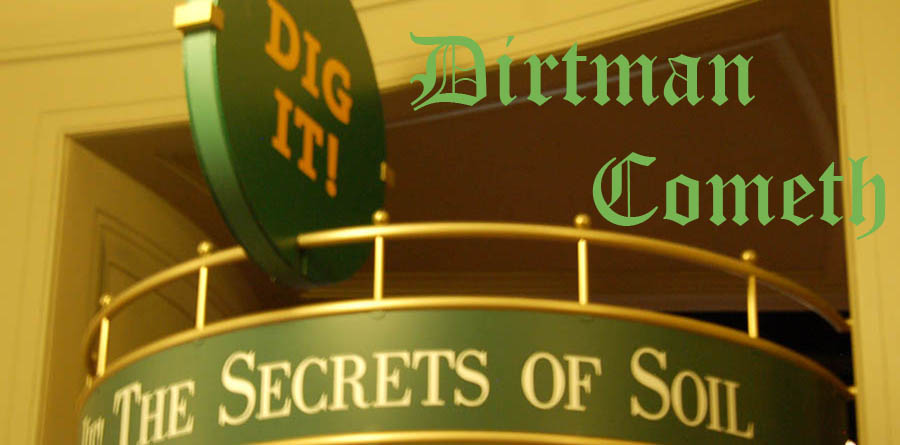The trip began innocently enough, though I think I may have gotten under Dark's skin a bit early on the Metro platform in Virginia.

 Exiting the escalator at the Smithsonian's Orange Line we were greeted by one of the city's many tour guides peddaling Official Smithsonian Tour Books at a bargain price of $1.
Exiting the escalator at the Smithsonian's Orange Line we were greeted by one of the city's many tour guides peddaling Official Smithsonian Tour Books at a bargain price of $1.
Unfortunately, I was more broke than he was and he refused my offer of me taking his picture for $2, so we moved northward where I took the obligatory photo of the Washington Monument
 and the obligatory photo of the US Capitol.
and the obligatory photo of the US Capitol.
I even managed a photo of Mr. and Mrs. Dark
 and SisIggy as we crossed the pea-graveled walkway.
and SisIggy as we crossed the pea-graveled walkway.


Our first stop was at the Museum of Natural History where I saw the next gadget Dark Garden will get for his West Virginia Crime Lab.
 I don't know what exactly he'll do with it and I don't know if he knows, but I am sure his next Homeland Security Grant will have the cash needed to import it from Canada.
I don't know what exactly he'll do with it and I don't know if he knows, but I am sure his next Homeland Security Grant will have the cash needed to import it from Canada.
We also saw the Giant Squid in the Sant Ocean Hall exhibit but it was too long to get
 photographed, and besides, I hate calamari. Sis likes the stuff but was afraid to say so.
photographed, and besides, I hate calamari. Sis likes the stuff but was afraid to say so.
Mrs. Dark allowed me to visit the Soils Exhibit that I once contributed a sum of cash too (when I had it). The exhibit includes monolithes of each state's (plus DC and Puerto Rico) official or, as in the case of Virginia the unofficial state soil.

Ours is Pamunkey -- the soil found around Jamestown and that which sustained the colonists in the early 1600s. So as to educate you, a monolith is a cross-section of the soil profile.
Technically, Pamunkey is a fine-loamy, mixed, semiactive, thermic hapludalf. For the scientists among us, I have included below the official soil description. For the unscientific - or for those who just doesn't give a damn - please skip below for the remainder of the travelogue.
PAMUNKEY SERIES
Soils of the Pamunkey series are very deep and well drained. They formed in Piedmont and Coastal Plain sediments. They are on nearly level to sloping stream terraces. Slopes range from 0 to 15 percent. Mean annual precipitation is about 48 inches, and mean annual temperature is about 59 degrees F.TAXONOMIC CLASS: Fine-loamy, mixed, semiactive, thermic Ultic Hapludalfs
TYPICAL PEDON: Pamunkey fine sandy loam - cultivated. (Colors are for moist soil.)
Ap--0 to 9 inches dark brown (7.5YR 4/4) fine sandy loam; moderate fine granular structure; very friable, slightly sticky, nonplastic; many fine and medium roots; 3 percent rounded quartz gravel; few fine flakes of mica; neutral; abrupt smooth boundary. (6 to 12 inches thick)
Bt1--9 to 11 inches; yellowish red (5YR 4/6) sandy clay loam; moderate medium subangular blocky structure; friable, slightly sticky, slightly plastic; many fine roots; few faint clay films on faces of peds; 1 percent rounded quartz gravel; few fine flakes of mica; slightly acid; clear smooth boundary.
Bt2--11 to 26 inches; yellowish red (5YR 4/6) clay loam; moderate medium subangular blocky structure; friable, slightly sticky, slightly plastic; common fine roots; common distinct clay films on faces of peds; common black stains on vertical faces of peds; 5 percent rounded quartz gravel; few fine flakes of mica; slightly acid; gradual smooth boundary.
Bt3--26 to 43 inches; yellowish red (5YR 4/8) sandy clay loam; weak coarse subangular blocky structure; friable, slightly sticky, slightly plastic; few fine roots; common faint clay films on faces of peds; common black coatings on faces of peds; 5 percent rounded quartz gravel; few fine flakes of mica; slightly acid; gradual smooth boundary. (Combined thickness of the Bt horizon ranges from 35 to 60 inches.)
BC--43 to 46 inches; yellowish red (5YR 4/8) sandy loam; weak fine subangular blocky structure; friable, slightly sticky, nonplastic; few faint clay films on faces of peds; common black stains; 10 percent rounded quartz gravel; common fine flakes of mica; moderately acid; abrupt wavy boundary. (30 to 12 inches thick) 30 to 60 inches)
2C--46 to 80 inches; stratified layers of yellowish brown (1OYR 5/6), strong brown (7.5YR 5/6), and reddish brown (5YR 4/4) sand and rounded greenstone and granite gravel; single grain; loose; few cobbles; common fine flakes of mica; medium acid.
The soil is found here in this part of Virginia:Okay, enough with the boring stuff already.


1 comment:
I just noticed that if I wasn't going to have my ashes spread out of a Chock-Full-O-Nuts coffee can, my skull would look strange. So... like... I appologize to you guys if I go first and you get stuck doing it.... and Yes.... It's in the will. Chock-Full-O-Nuts.
Post a Comment